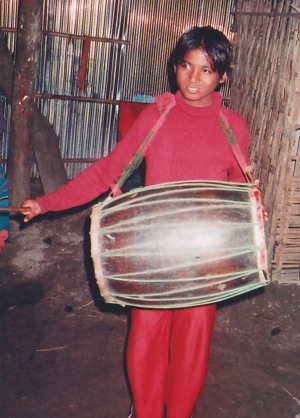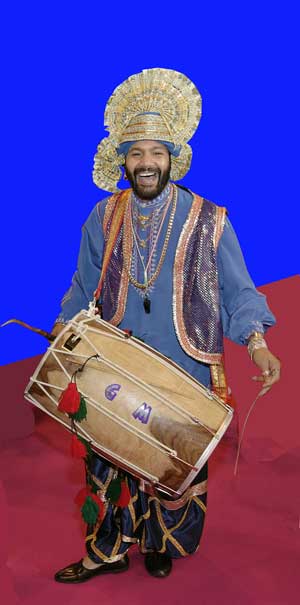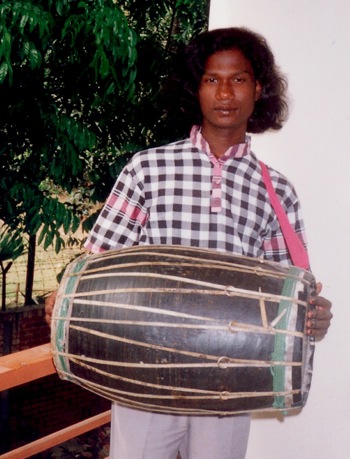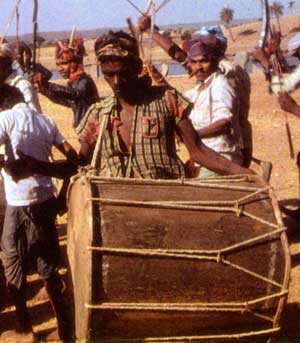
photo courtesy of Mir Ali Akhtar
Dhol is a very popular folk drum of northern India, Pakistan and Bangladesh. It is a barrel shaped, sometimes cylindrical drum, with skins on both sides. It has one side which has a high pitch and another side which has a lower pitch. It is very popular in folk music. The dhol is essentially nothing more than a larger version of the dholak.
The term “dhol” has a generic quality about it. Virtually any large barrel shaped or cylindrical drum may be called a dhol. Therefore, whenever one wishes to be more specific one generally attaches a descriptive term to make things clear (e.g., “bhangra dhol”).
The history of the dhol is not clear. One source of confusion may be that the origin of the term “dhol” may be different from the origin of the instrument itself. The word “dhol” is probably of Persian origin. It is probably derived from the Persian “dohol” or “duhul”. However images of dhol players appear to be present in the bas relief carvings on Indian temple walls from the earliest times. It is possible that both the instrument as well as the name have some deep Indo-European connection. However, at this point it is just really difficult to make any firm statement as to the origin of the instrument.
As one moves around North India, Pakistan, and Bangladesh, one finds considerable variation in the technique. One finds the use of hands, sticks, and various combinations of both. The most well known style is the bhangra style which uses sticks on both sides. There is also variation as to whether the low pitched side should be played on the left side or the right side. Throughout most of South Asia, it is more common to play the lower pitched side with the left hand.
Construction
The construction of the dhol is a very interesting affair. Naturally there are regional differences. Even within one region, there are differences from one maker to the next. However, we can discuss a number of general aspects concerning the making of the dhol.
One of the most important parts of the dhol is the shell. There are regional variations as to both the size, dimensions, and the woods used. It will generally be cylindrical or barrel shaped. The most commonly used woods are mango wood and shisham
Mango-wood (genus – mangifera)is commonly used for the drum shell. There are advantages and disadvantages to this wood. On the positive side, mango wood (a.k.a. “aam”) is extremely light; this is a very important consideration for a drum as large as the dhol, because the majority of the weight of the instrument is made up of this shell. Another advantage is that mango trees are readily available. However, mango wood is not without its disadvantages. Mango wood is general considered to have a sound which is much thinner than other heavier woods. Undoubtedly the biggest disadvantage of mango wood is its susceptibility to insect infestation (i.e., the “false powder-post beetle” – Xylopsocus capucinus ). However, this problem is often addressed by liberal applications of an infusion made from the neem tree; this is a well known natural insecticide
Shisham (genus – dalbergia) is another wood which is commonly used to make dhols, this too has advantages and disadvantages. One advantage of shisham is its superior sound quality. It also has the advantage of being very resistant to insects. Unfortunately shisham is a very hard wood, so it is difficult to cut and work with. Furthermore it is extremely heavy, so instruments made of shisham are difficult to carry and even more difficult to dance with.
One may find a variety of skins and membranes used to skin the drum. The most common is goatskin, but the past few decades have seen a rising popularity of artificial materials. Generally a thicker skin is used on one side, this thicker skin is then sometimes loaded with a small amount of a pitch-like application known as “dholak massala”. The combination of the thicker skin and the acoustic loading of the application gives this side a deeper sound. On extremely rare occasions one may find an application to the thinner, high pitched head.
There are several ways of tightening the dhol. Sometimes they are laced with rope, or rawhide, in which case, a series of metal rings are often used to pull and tighten the instrument. Sometimes metal turnbuckles are employed.
Punjabi (Bhangra) Dhol

The dhol in Punjab plays a very important part in the local culture. It has emerged as an instrument that Punjabis use as a symbol of their ethnic identity. This strong attachment is especially evident among the expatriate Punjabi communities dispersed across the earth.
The use of the dhol is varied in the Punjab. Its use is not limited to artistic events, because it is found at political rallies, sporting events, and virtually any place that one wishes to create a festive mood.
The Punjabi dhol is also known as the “bhangra dhol”; this is due to its importance in the folk dance/ song style known as bhangra. Since the bhangra has attained a worldwide audience, this version of the dhol is probably the most well known example.
The orientation of the Punjabi dhol is fairly standard. The deep side is generally played with the left hand while the treble side is generally played with the right hand. Of course, this may be reversed for left-handed performers
The Punjabi dhol tends to be played with sticks on both sides. However the sticks are different. There is a curved drumstick known as the dagga, and a straight drumstick known as the chanti. The chanti (straight drumstick) is used upon the high pitched side which is referred to as the “madeen”. This drumstick is generally made of a light material such as cane. The curved one (dagga) is used on the deep pitched side side (nar); this drumstick is made of a heavier wood.
The construction of the dhol in Punjab is not significantly different from what it is in other parts of India, Pakistan, and Bangladesh. There are but a few small exceptions. Most of the differences are merely one of nomenclature. Let us now look more closely at these small Punjabi characteristics.
There is a tendency for the Punjabi dhol to be a bit smaller and a bit lighter than elsewhere in the subcontinent. Many times it is barely larger than the dholak. The heads on the Punjabi dhol tend to be around 13 inches, while the shell balloons out to a diameter of around 15 inches. This small size reflects the tendency for Punjabis to dance and run around with the dhol during a performance.
As in other parts of India, there are a variety of tightening arrangements. There are rawhide lacings, rope, and, screw turnbuckle systems. One curiously Punjabi innovation is a hybrid where one finds turnbuckles (screws) on one side and rope lacing on the other.
The wood that one generally finds on the Punjabi dhol is either mango (aam) or shisham. In Punjab, shisham is known as “taahlli”. However since a light portable dhol is more important to Punjabis, the heavy weight of shisham is a disadvantage.
The heads have traditionally been of goat skin, but as the Punjabi dhol has risen in international popularity, one is finding plastic and other artificial materials being used.
There is one decorative aspect of the Punjabi dhol which deserves attention. Tassels are an obligatory addition to the Punjabi dhol. These are usually attached to the tightening rings.
Traditionally, dhol players occupied a lower strata of society; this however is changing. The urbanisation and internationalisation of bhangra is reflected in the fact that dhol players may now come from any strata of society. Even women are now taking up the dhol.
Kanthi Dhol (a.k.a. Bangla Dhol)

photo courtesy of Mir Ali Akhtar
The kanthi dhol, sometimes pronounced kathi dhol, or even “bangla dhol”, is a commonly used drum found in Bangladesh, West Bengal, and parts of North-East India. The word “kanthi”, is linked to the term “kath” or “kashth”, which means “wooden”. The term is in reference to the wooden drum-stick (i.e., the kanthi) used to play the drum. This is to distinguish it from the hand drums (e.g., khol, dholak, maddala, etc.) which are also found in the area.
The Bengali kanthi dhol is commonly used on many occasions. It is used to accompany a variety of folk music and dance, such as Bengali folksongs (vaoaiya/chotka ‘ashor’), and the “lathi” (bamboo) dance. It is also used to provide an environment for non-musical events such as the annual procession of Muharrom, boat races, marriages, and a variety of festive occasions.
In Bengal, the person who plays dhol is called a “dhuli”. They allow their hair to grow very long. This long hair is used to great artistic effect by shaking it from side to side as they play the dhol.
The technique of the dhol utilises both hands. In the right hand a kanthi or small bamboo or cane stick is used as a drum-stick. The left side is generally played with the fingers. However, drum-sticks are sometimes used to play both sides of the dhol. Some performers use two metal coverings for the index and middle fingers. They place these rings over the finger tips, to produce a sharper sound than would otherwise be obtained.
The making of the Bengali kanthi dhol is a highly developed art. Here are some important points.
The drum-shell is an extremely important part of the dhol. This shell is known as the dhor. It generally starts with a cylindrical or barrel shaped piece of wood. The following dimensions are generally used for the Bengali kanthi dhol. It is generally two feet long. Circumference in the middle of the dhor (shell) is about three feet. Both ends have circumferences which are considerably less.
Goat hide is used to cover both openings (chauni). These skins are wrapped over bamboo rings (gojra/chak) and then fitted over the shell (dhor) by rawhide lacing, string, or rope. This lacing often passes through metal rings to facilitate tuning. The hides are not the same thickness. The left hand skin is thicker than that of right hand side. This thicker left hand skin, when combined with the pitch-like application on the inner surface, gives the left side a substantially deeper sound.
There are a few accessories to the Bengali kanthi dhol. One of these is a cloth which wraps around the drum; this is primarily decorative. This cloth is known as “Gamcha”. There is also a strap which allows the dhuli to hang the dhol around their neck, thus allowing the performer to walk and play at the same time.
The Dhol in Other Areas
There is a presence of the dhol throughout Northern India, Pakistan, and even into the Middle East. Some discussion of the dhol in these other parts is in order.
Gujarat – The dhol has a significant presence in the North Western state of Gujarat. However unlike the situation in the Punjab where the dhol is directly identifiable with Punjabi culture, the situation in Gujarat is more indirect. It is the dance forms raas and garba which are inextricably linked to the Gujarati sense of self identity, but the dhol is an important accompaniment to this dance. However unlike the situation in Punjab, the veneration afforded to the raas, and garba does not rub off on the dhol. Compared to the situation in the Punjab, the dhol is greatly taken for granted.
South India – The dhol has a very limited presence in Southern India. This is because the social and musical role that it plays in the North is solidly occupied by other instruments; the most notable is the tavil. Where weddings, processions, and other festive events in the north would find the presence of the dhol an indispensable component, in the south one finds the presence of the tavil.
It is arguable that the tavil is nothing but a south Indian version of the dhol. One could point to the myriad similarities of technique, cultural significance, and structure of the instrument to make this statement. Unfortunately this comes down to a “glass half full, or half empty” situation, because one could just as easily point to the differences to argue that there is no connection between the two instruments. We can only bring this up as an idea for consideration without making any judgement.
Tribal India – The dhol is well represent in the music of the Indian tribals. There are so many variations in technique and construction that entire books could be written on the subject. Unfortunately there is no single culture or single entity that can be defined as tribal India, for it is a collection of largely unrelated smaller cultures. Therefore, it is pointless to try and make any definitive statements about the use of the dhol in tribal societies. The most that we can say is that it is fairly common.

Pakistan – The situation in Pakistan is a complex one. There is a curious mixture of acceptance and rejection of the dhol, the dholis, as well as music in general.
There are some positive aspects. Some have suggested that the dhol is of Persian import, and the area of present day Pakistan may be one of the first areas of South Asia to adopt this instrument. The dhol, is often used by Sufis and is commonly found at qawwali performances at dargas (burial shrines to Muslim saints) and other pilgrimage places.
But all is not well in this regard. The performers of the dhol have long occupied a lower position in Pakistani society. For as long as anyone can remember, musicians have been marginalised in this region; but the situation is getting worse. The rise of Wahhabi influenced fundamentalism is putting Sufism, music, and musicians on the defensive.
Other Countries – The dhol is present throughout the Middle East and Eastern Europe. It is only natural that as we move through such a diverse linguistic area that there will emerge major changes in pronunciation and nomenclature. For instance in Afghanistan and Persia, the dhol is referred to to as “duhul”, or “dohol”. The construction also begins to change. It begins to change its form and morph into the “tabl-baladi” of Egypt, or the medieval tabor found in Europe. All of these are interesting, but it becomes clear that we are geographically, culturally, and historically at the very boundaries of the dhol.